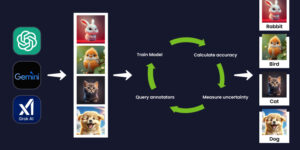
For tech companies that need annotation, data annotators play a critical role. Data annotators can significantly enhance AI algorithms. However, it is crucial for companies to hire highly qualified and skilled data annotators for the role. This is because only highly skilled and experienced data annotators can analyze dataset patterns accurately and can then label or tag them. These professionals have become a crucial part of the industry ever since the introduction of AI and ML. They simplify the task of data annotation for tech companies worldwide. However, there are numerous automated data annotation tools that may offer the same kind of services but not with the same precision. The major difference between roles and responsibilities of data annotator and automated tool is that data annotators pay attention to minute details while training machine algorithms, but that’s not the case with the tools.
If you are planning to enter the field of data annotation or are looking a data annotator job, then you should be aware of the roles and responsibilities they undertake. This article has it all that you need to know about the data annotator job profile. Here, we will discuss the significant roles and responsibilities of a data annotator. So, let’s walk you through this useful guide. Here we go…
Table of Contents
- Who is a Data Annotator?
- What do you do as a Data Annotator?
- Data Annotator Roles and Responsibilities
Who is a Data Annotator?
A data annotator is a professional who develops precise datasets to make them more understandable for machine algorithms. They play a crucial role in an organization using AI technology. They’re responsible for labeling and categorizing data to train machine learning models and artificial intelligence systems. They meticulously examine and analyze datasets, ensuring that the data labeling or tagging is accurate and valid. Their role involves adding metadata to various types of data, such as images, text, audio, and video, to create structured datasets from which machine algorithms can learn. Data annotators must have the ability to pay attention to details. They ensure the accuracy and reliability of AI systems. They can work in a wide range of industries, including finance, healthcare, IT, autonomous vehicles, and so on.
What do you do as a Data Annotator?
Data annotators utilize the power of the human brain immensely. As a data annotator, you should use your natural ability to understand context, sentiment, nuances, images, and other complex datasets. This is a vital step to do precise and accurate dataset tagging or labeling. They are able to understand complex datasets and label them.
These professionals use a combination of manual techniques and automated tools to perform their tasks, adhering to strict guidelines and protocols to minimize errors and biases. Their training lays a strong foundation upon which AI algorithms and predictive models are built. Therefore, AI tech companies look for highly qualified data annotators that can provide them with high-quality datasets. This is because the quality of datasets impacts the performance of the AI model. Lack of knowledge in the field can lead to misleading information. Therefore, it is crucial for a data annotator to have sufficient knowledge and training to excel in the field.
The label and tag datasets to ensure a better understanding of AI or machine learning algorithms. Doing it accurately enhances the capabilities of AI predictive models. Let’s understand this with an example:
In the finance sector, you will be assigned to label or tag datasets to train machine algorithms. You need to categorize the dataset into various groups and tag the text with appropriate keywords. This helps AI models understand market trends and patterns. By putting in the necessary effort, you can create a strong system that effectively predicts market trends and stock volatility.
Let’s now understand the roles and responsibilities of data annotators in detail. Here we go…
Data Annotator Roles and Responsibilities
Understanding the roles and responsibilities of a data annotator can give you a direction to grow. Before you enter this world, it is vital to be aware of your job role for deeper understanding. Scroll down to read the roles and responsibilities of a data annotator in detail…
➯ Tagging
As a data annotator, you should know how to tag images, text, audio, and video. Having knowledge of tagging will ensure the proper organization of complex datasets. You do it by dividing datasets into different categories. This helps machine algorithms in identifying text or objects in a dataset. Aside from this, it also makes machine algorithms understand relationships or differences between different sequences or objects. Tagging requires close attention to details. Hence, as a data annotator, you should be able to pay attention to minute details. This can help you create flawless and high-quality annotations.
For example, when tagging documents, it is important for data annotators to ensure that machine algorithms have a clear understanding of the entire sequence. It indicates that they have not only acquired the ability to recognize text but also grasp the connections between sentences.
➯ Classification

Classification is yet another important responsibility that a data annotator takes care of. Classification in data annotation is a subset of tagging. Data annotator aims to train machine algorithms on how to put data into particular categories for easier navigation. This technique works well with handwriting recognition, speech recognition, face recognition, and document classification.
For instance, data annotators train modern security cameras to identify potential intruders with the help of face recognition.
➯ Segmentation
The next responsibility of a data annotator is segmentation. For the text segmentation, they break up text into different sections. On the other hand, when it comes to images, they need to divide a digital image into various pixels for image or video segmentation. Segmentation ensures that machine algorithms are trained to classify the objects and backgrounds within an image or text.
➯ Detailed Classification
The possibilities in data annotation and machine algorithms are limitless. Therefore, a data annotator can be tasked to do the detailed classification of images. This usually includes training machine algorithms used in medical imaging for precise assessments. So, they do not categorize datasets into general groups but they pay attention to minute details of images. Consequently, they break down datasets into finely tuned categories, each carrying a specific and in-depth meaning.
➯ Validating the AI Models Output

The role and responsibility of the data annotator do not end just with the encoding of information. After the encoding of information, data annotators need to examine the results given by the trained machine algorithms. Only after data annotators validate their performance, they are made available to others to leverage their benefits and boost productivity.
➯ Research, Discover and Annotate
Machine algorithms can think like human brains. But that can only be possible when the data is annotated accurately. The role of a data annotator is an unending process. This is because they have to research, discover new insights, and annotate new learnings to train machine algorithms again. In a nutshell, they consistently improve the AI models to enhance their predictive capabilities and foster innovation.
➯ Multimodal Data Integration
Data annotators need to integrate multimodal data. Their role is to combine different types of data taken from different sources into a dataset. This includes a wide range of data such as voice, images, text, or video. Data annotators utilize all these datasets to form annotated datasets. By employing multiple data integration, data annotators make machine algorithms more advanced and more capable of making informed decisions.
Key Takeaway
So, this is all about the roles and responsibilities of data annotators. Undoubtedly, data annotators play a pivotal role in the digital realm. Their attention to detail in labeling and categorizing data acts as the bedrock for AI systems, directly influencing the precision and efficiency of these technologies. Data annotators must possess the immense knowledge and technical skills required to excel in the field. There is no dearth of jobs in the field, provided you possess all that is required to label and tag data accurately. With the increasing demand for AI in various industries, the demand for skilled data annotators is sure to go up. By understanding and embracing the complexities of their role, you would be able to make it big in the field of data annotation. So, keep learning, exploring, and growing.
Let’s now take a look at some of the FAQs. Here we go…
FAQs
Q1. Are data annotators salaried?
Well, it depends on the nature of your work. If you are working in a company as data annotator, then surely you will be paid on monthly basis. Whereas, freelancers charge on hourly or project basis.
Q2. What is the salary range for a data annotator?
A freelance data annotator can charge somewhere between $10-$60 an hour, depending on the skills and experience that you possess. However, the average data annotator salary is somewhere around $45,000 per year and can go up to $70,000 per year. For beginners, the salary starts at $40,000 per year.
Q3. Is data annotation a lucrative profile?
Yes, data annotation tech is a lucrative industry. With the increasing demand for AI, the demand for data annotator roles is sure to go up. Moreover, it is an exciting role in which data annotators streamline complex datasets for training machine algorithms and artificial intelligence. They are in high demand worldwide. You can work anywhere in the world if you possess knowledge and training in this domain.
Q4. What do data annotators need to do?
Data annotators need to have skills to analyze patterns and sequences of datasets. A data annotator has to go through the minute details of a huge dataset to label or tag it. They should have the ability to pay close attention to details to ensure annotated data is of high quality, consistent, and well-researched.
Q5. How to qualify for a data annotation job?
For a data annotation job, it is crucial to have a keen eye for detail and be proficient in using data annotation tools and software. In addition, it is important for individuals to have effective communication skills as they need to work in teams.
Thanks for reading! Stay tuned for more such insightful articles!






